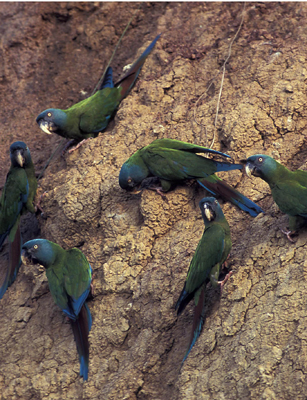The Blue-throated Macaw (BTM) 2007 field season is well underway. I've just finished orientating our new coordinator for the project. After four field seasons here in Bolivia I felt it was time to move on to other things.
My replacement is an Argentine, Igor Berkunsky (of Ukrainian descent if you're wondering about his name). He did his PhD studying Blue-fronted Amazons in the Argentine Chaco for five years and is ideally suited to take the reins of the BTM project. He's worked with over 130 nests and the field conditions of the Chaco should making working in the Llanos de Moxos (where Blue-throats are found) a cake walk. Temperatures in the Chaco can get up to 45 ºC (125 ºF) at midday and water is so scarce, field workers have to use second hand bath water to wash dishes.
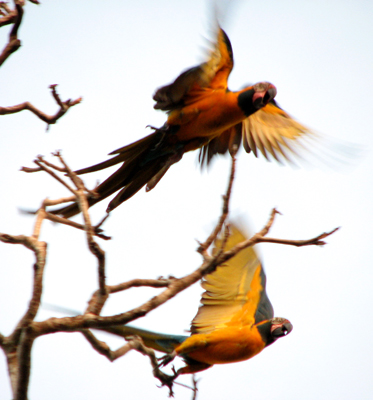
I should apologize for neglecting this blog for so long. I made a much needed trip back to Canada (the first in almost four years). I'll make up for the abstinence by including a lot of photos in this entry. Eye candy for your enjoyment.
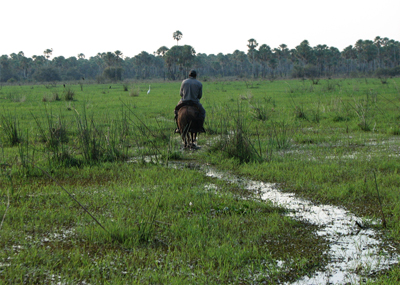
The past month has been a whirlwind tour of showing Igor as many Blue-throats and nest trees as possible in the field while introducing him to important contacts and dealing with the bureaucratic side of things in town. August is usually one of the driest months of the year in terms of field conditions though 2007 has proved to be an exception. This year will go down as an El Niño year which in this part of Bolivia means rainfall was heavier than normal. The main river in our study area, the Mamoré, flooded extensively in March causing humanitarian crises in many populated areas and killing thousands of livestock, the main economic activity in the region. Even in August some areas were still flooded, necessitating the use of horses to get around, something we don't normally do until November.
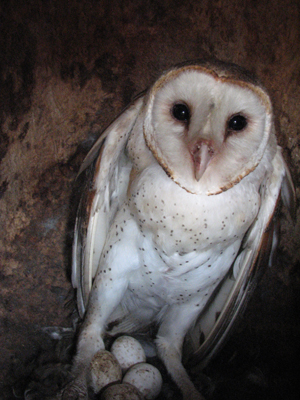
It's hard to say how the flooding will effect this breeding season. On the one hand, increased rainfall should translate into more fruit production and thus more food resources available to Blue-throat breeding pairs. On the other, things appear to be more out of whack compared to previous years. For example, in August it's not unusual to find large Barn Owl chicks Tyto abla in nest cavities also occupied by macaws later on in the year. This past month we found two Blue-throat nests occupied by Barn Owls but the females had only recently begun incubating.
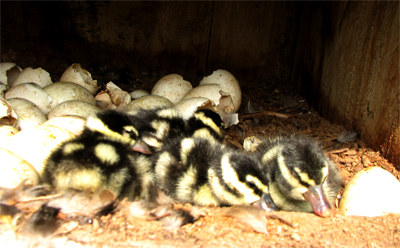
Also, a larger proportion of nest cavities had been taken over by Africanized bees compared to past nesting seasons. This complicates our work as one of the goals of our project is to provide as many nest cavities as possible to prospective Blue-throat nesting pairs. It's difficult to say if the increase in bees and delay in Barn Owl breeding are a result of the increased rainfall or due to other factors but they may result in fewer nesting attempts by Blue-throats this year (unless we 'clean out' the bees like we did with one successful nest last year). On the bright side of all of these concerns for the effects of El Niño is that we already have an active nest. This nest began incubating the first week of August, the earliest active nest I've seen in five field seasons.
It was also interesting to inspect the numerous nest boxes we put up last season. Many of them were occupied by bees (the bane of my existence last month!) but a few were full of Black-bellied Whistling Duck chicks Dendrocygna autumnalis. One of them plummeted to the ground the first time I opened the side door to the box to see who was inside. Was it hurt in the fall? Not a chance. These ducklings are anatomically designed to weather such a fall as they are still incapable of flight by the time the exit the nest. Hence the origin of the term 'rubber duckies'.
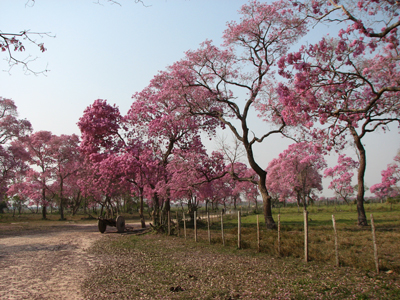
Even though only two seasons exist in the tropics, namely the wet and dry, the end of the dry season in August still feels like spring in a way. Many trees are in flower including these Tajibo trees which reminds me of Japanese cherry blossoms, a riot of pink everywhere but an ephemeral beauty. There one day and absent the next.
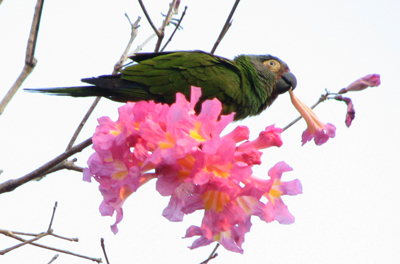
Numerous parrot species are attracted to the nectar of the flowers which add to the colour spectacle, throwing irridescent greens, blues and yellows into the mix. A Dusky-headed Parrot Aratinga wedelli gracefully illustrates the phenomenon below.
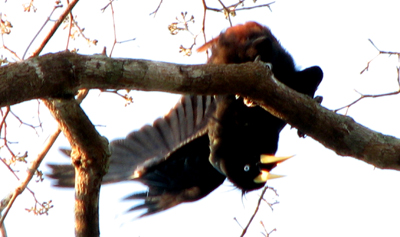
Numerous bird species are preparing their nests for the coming breeding season and males sing and display throughout the day, including the Crested Oropendula Psarocolius decumanus whom I caught in mid-display as he tried to lure females nearer to his nest. Yes, they display upsidedown.
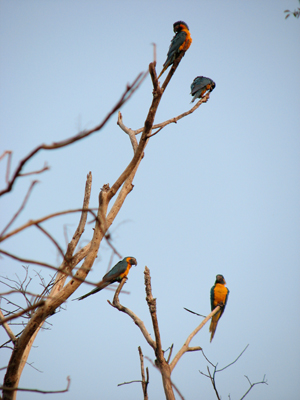
The highlight from the field last month was in the 7 Islas areas. This was our most successful area from last season with three chicks fledging in late December. Of course I was interested to see how many of those chicks had survived thus far. Early one morning Carmen Silva, a volunteer from last year who is a now a paid field assistant this season, and myself were walking down to the end of a forest island and when were stopped dead in our tracks by the sight of several Blue-throats in a tree ahead of us. It was comical how we both started counting out loud to ourselves, "Four. No! Six! No! Seven! There's seven here!!!". We'd already seen four other Blue-throats in other areas that morning so there were at least 11 birds around. A small miracle given how rare Blue-throats are. Examining facial feather line patterns, which are unique for each Blue-throated Macaw, I recognized two birds as the pair which had fledged two chicks around last season. Sure enough there were two chicks perched above them. I was so happy. They'd both made it this far.
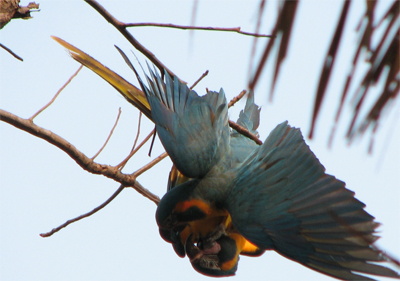
It's a bit hard to put into words how I felt when I saw those chicks. In essence they represent what our project is all about, hope for the future for this species in the wild. At the same time because I've spent four field seasons working with Blue-throats, many memories, good and bad, drifted over me as I watched them that morning play and clown around with one another.
Since I'm leaving the project it is perhaps expected that I reflect on whether or not I've made a difference with my time here in Bolivia. Having a morning like that one in 7 Islas is reassuring on many levels. In my opinion we are a long way from having Blue-throats fully recovered but during my time with this project I feel we've identified many aspects of their breeding ecology we can manage more successfully to help get more chicks into the wild each season. I've communicated as much of this knowledge as possible to Igor during our month together and now where our project succeeds or fails lies with him. From what I've seen from our time together, the future of Blue-throats is in good hands. That's him below checking out a potential BTM nest.
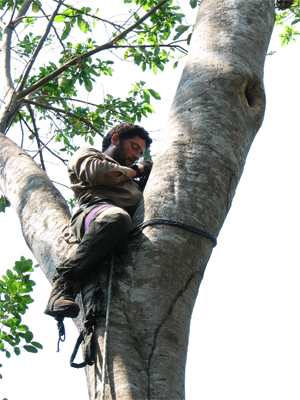
So what's next for me? Later this month I'll be heading over to Peru to look for Blue-headed Macaws Primolius couloni. I did my thesis work in the Peruvian rainforest in 1999 and 2000 and truth be told, I have never seen jungle as rich in wildlife as there since. It's going to be a welcome home coming of sorts.
Blue-headed Macaws are the least studied macaw, and incidentally the only species of macaw I've yet to see in the wild. There's a pressing need to get a better sense of where the species is distributed as well as basic elements of their natural history; what they feed on, their nesting habits, etc. I read recently that due to their rarity, they fetch almost $USD 3500 each on the black market in Peru, so I'm also curious to learn about trapping pressures, if at all possible. I don't expect to answer all of these questions with the relatively short time I'll have to study them but given how little is known about these birds, any information I can collect for them will help. The photo below was taken of Blue-headed Macaws at a clay lick in Peru by a colleague of mine, Luis Claudio Marigo. God willing I could take pictures like his!
